Attacking Aluminum: a Machining Guide
Aluminum is one of the most commonly machined materials, as most forms of the material feature excellent machinability, and is thus a commonly used material in manufacturing. Because of this, the competition for aluminum machining can be intense. Understanding the basics behind tool selection, running parameters, and advanced milling techniques for aluminum can help machinists earn a competitive advantage.
Material Properties
Aluminum is a highly formable, workable, lightweight material. Parts made from this material can be found in nearly every industry. Additionally, Aluminum has become a popular choice for prototypes due to its low-cost and flexibility.
Aluminum is available in two basic forms: Cast and Wrought. Wrought Aluminum is typically stronger, more expensive, and contains a lower percentage of outside elements in its alloys. Wrought Aluminum is also more heat-resistant than Cast and has a higher level of machinability.
Cast Aluminum has less tensile strength but with a higher flexibility. It costs less, and has higher percentages of outside elements (silicon, magnesium, etc.) in its alloys, making it more abrasive than Wrought.
Shop Helical Solutions’ End Mills for Aluminum & Non-ferrous Materials
Tool Geometry
There are a few coating options available for Aluminum tooling, including the popular gold-colored ZrN (Zirconium Nitride) and the lesser known but highly effective TiB2 (Titanium Diboride). Uncoated tooling can also provide solid machining performance. However, the real key to high performance machining in Aluminum is knowing the proper flute count and helix angle required for your operation.
Flute Count
End mills for aluminum are often available in either 2 flute or 3 flute styles. With higher flute counts, it would become difficult to evacuate chips effectively at the high speeds at which you can run in aluminum. This is because aluminum alloys leave a large chip, and chip valleys become smaller with each additional flute on an end mill.
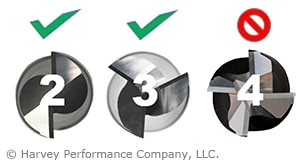
Traditionally, 2 flute end mills have been the preferred choice for Aluminum. However, 3 flute end mills have proven to be more successful in many finishing operations, and with the right parameters they can also work successfully as roughers. While much of the debate between 2 and 3 flute end mills for Aluminum boils down to personal preference, the operation, rigidity, and desired material removal rates can also have an effect on tool selection.
Helix Angles
The helix angle of a tool is measured by the angle formed between the centerline of the tool and a straight line tangent along the cutting edge. Cutting tools for aluminum typically feature higher helix angles than standard end mills. Specialized helix angles for Aluminum are typically either 35°, 40°, or 45°. Variable helix tools are also available and make a great choice for reducing chatter and harmonics while also increasing material removal rates.
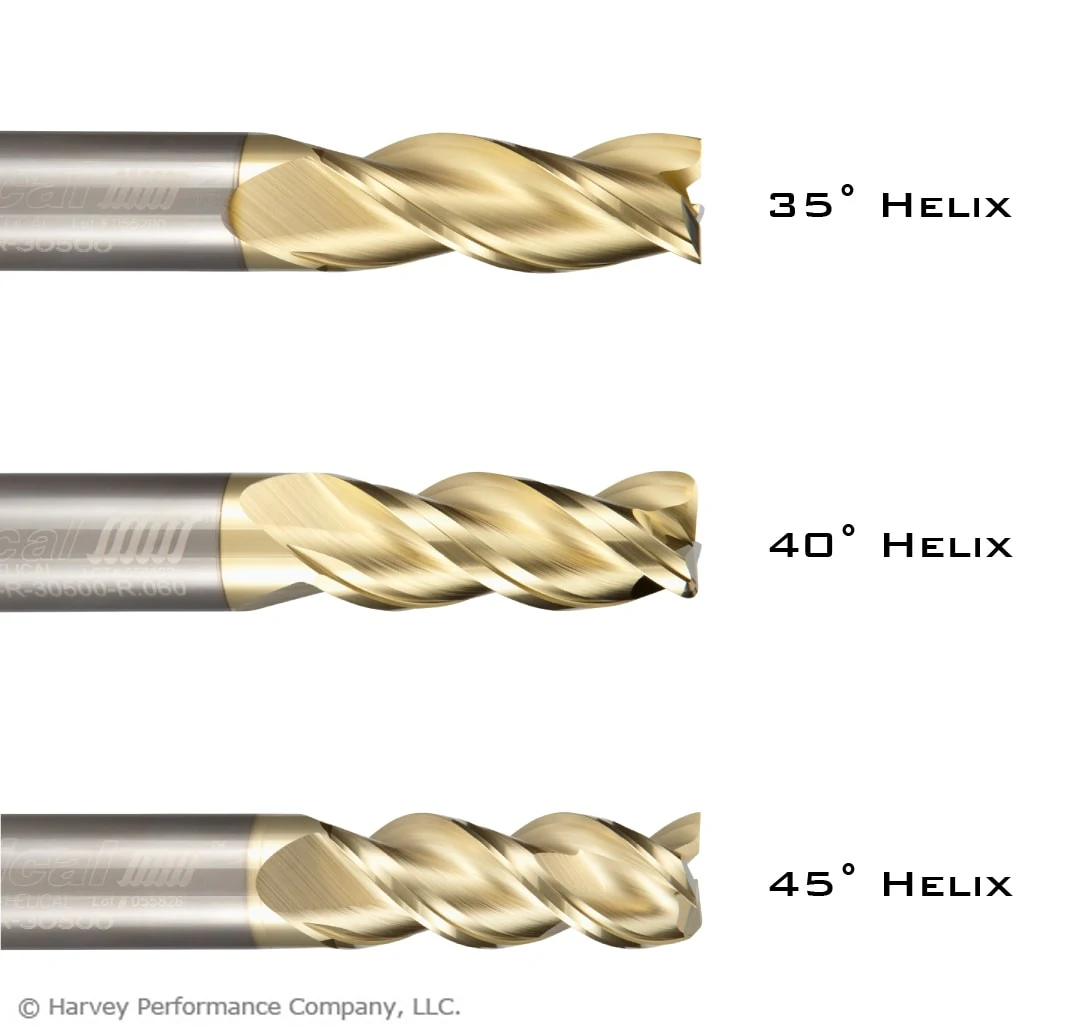
A helix angle of 35° or 40° is a good choice for traditional roughing and slotting applications. A 45° helix angle is the preferred choice for finishing, but also for High Efficiency Milling toolpaths as the high helix angle wraps around the tool faster and makes for a more aggressive cut.
Tooling Options
When machining aluminum, standard 2 or 3 flute tools will often get the job done. However, for certain applications and machine setups there are some more tooling options to consider for even better performance.

Chipbreaker Tooling
One of the most important things to consider when machining aluminum (and many other materials) is effective chip evacuation. Standard 2-3 flute end mills running at recommended speeds and feeds and proper chip loads can evacuate chips fairly well. However, 3 flute chipbreaker tooling can run at increased speed and feed rates for even better performance. The unique offset chip breaker geometry creates smaller chips for optimal evacuation while still leaving a semi-finished surface.
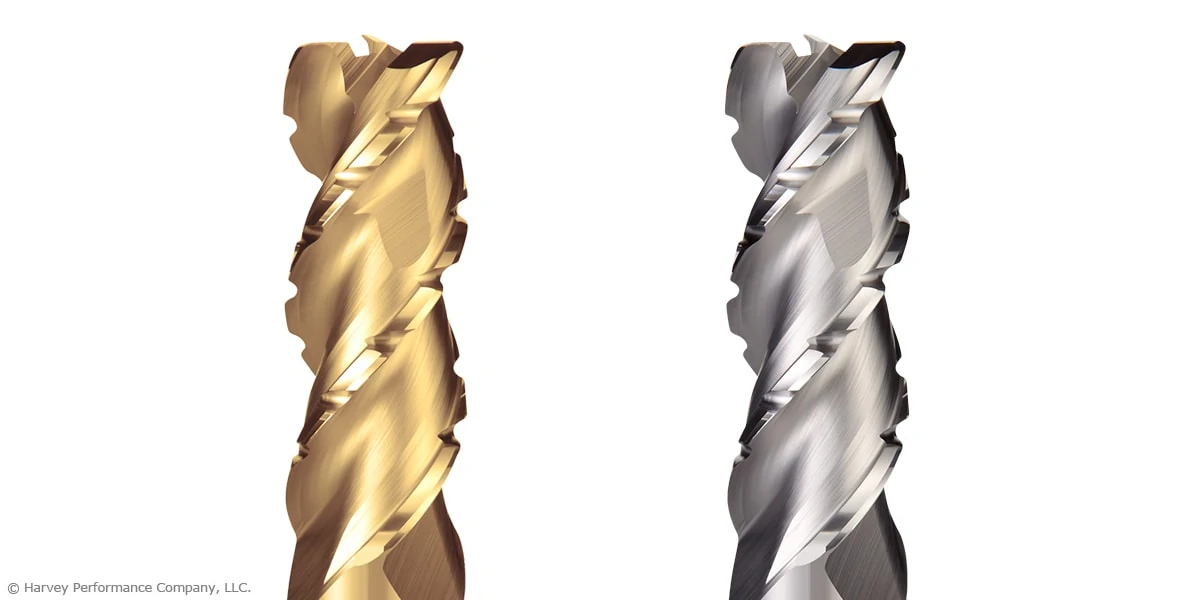
These tools are excellent for more advanced toolpaths like High Efficiency Milling, which is another important tool for a successful aluminum machining experience.
High Balance End Mills
High balance end mills are designed to significantly increase performance in highly balanced machining centers capable of elevated RPMs and feed rates. These tools are precision balanced specifically for high velocity machining in aluminum (up to 33,000 RPM).
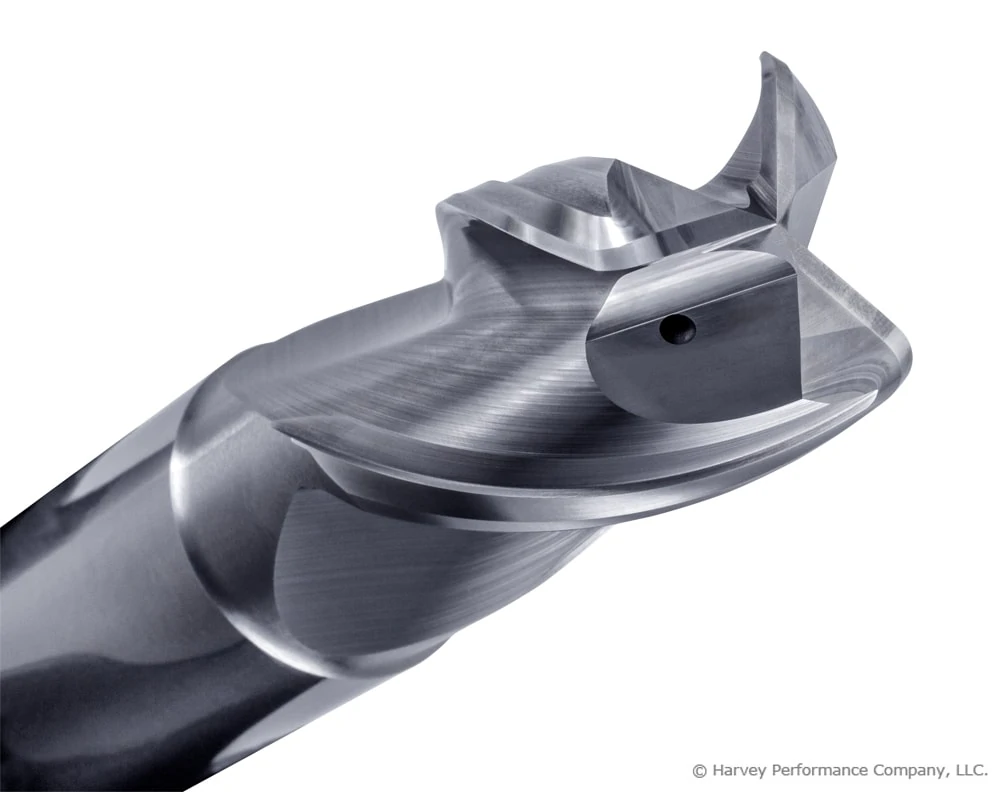
Helical Solutions offers high balance tooling in standard 2 flute styles, as well as coolant-through 3 flute styles for reduced heat, enhanced chip evacuation, and increased material removal rates. These tools, like the chipbreakers, are also an excellent choice for High Efficiency Milling toolpaths.
Running Parameters
Setting the right parameters for aluminum applications is vital to optimizing productivity and achieving better machining results. Since aluminum is an easier material to machine, pushing your machine to its limits and getting the most out of your tool is vital to stay ahead of the competition and keep winning business.
While there are many factors that go into the parameters for every job, there are some general guidelines to follow when machining aluminum. For cast aluminum alloys (i.e. 308, 356, 380), a surface footage of 500-1000 SFM is recommended, with RPMs varying based on cutter diameter. The basic calculation to find a starting point for RPMs would be (3.82 x SFM) / Diameter.
In wrought aluminum alloys (i.e. 2024, 6061, 7075), a surface footage of 800-1500 SFM is recommended, with the same calculation being used to find a starting point for RPMs.
High Efficiency Milling
High Efficiency Milling, commonly known as HEM, is a strategy that is rapidly gaining popularity in the manufacturing industry. Many CAM programs are now including HEM toolpaths, and while virtually any machine can perform HEM, the CNC controller must feature a fast processor to keep up with the additional lines of code. A great example of High Efficiency Milling toolpaths in Aluminum can be seen below.
At its core, HEM is a roughing technique that utilizes a low Radial Depth of Cut (RDOC) and a high Axial Depth of Cut (ADOC) to take full advantage of the cutting edge of the tool. To learn more about how High Efficiency Milling can increase your efficiency, extend your tool life to keep costs down, and get greater performance for aluminum (and other materials), click here to download the HEM Guidebook.
In Summary
Aluminum is a versatile material with a high level of machinability, but it should not be overlooked. Understanding the best ways to tackle it is important for achieving the desired results. Optimizing your tool crib, machine setups, and toolpaths for aluminum is essential to stay ahead of the competition and make your shop more efficient.
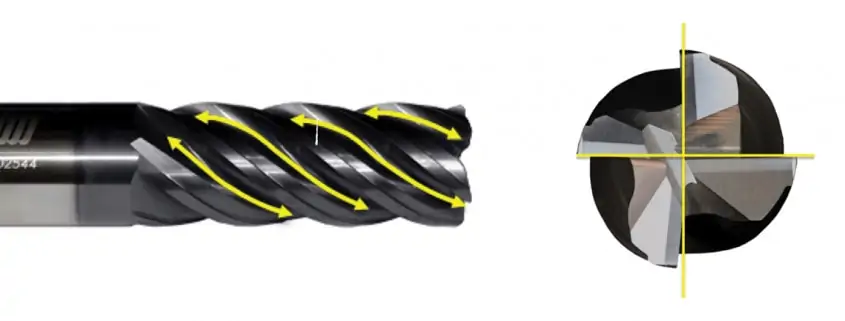


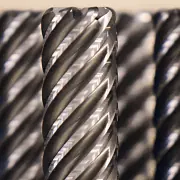
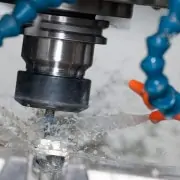
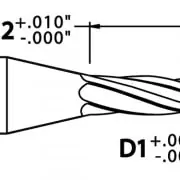
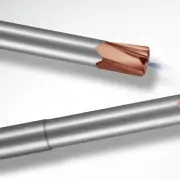



In my experience, roughing style corncob type endmills will get you the highest MMR’s with your available hp at the spindle. I’ve been machining a job constantly on the search for a better roughing tool to increase the MMR. I’ve found HEM’s efficiency is entirely dependent on the part geometry that you are applying the toolpaths too. If your part dictates that there are substantial retracts/entries/exits from cutting, you may find that your sexy super fast feed rates end up with longer cycle times as you spend more time cutting air. I’ve spend countless hours on this, and even with the roughing tool I’m currently having major success with, it’s taken time to dial in the most efficient Spindle speeds and feeds. It’s not just about firing up the machine to the highest RPM and having at it. You need to find the sweet spot in the spindles torque curve. Once you’ve found where that is, then you can start jacking up feed rates and playing with axial and radial DOC’s
The article claims that a higher helix angle (45 degrees), makes for more aggressive cutting. If you look at the pictures you show of three endmills with 35, 40, and 45 degree helix’s, the one that would lift the chip further with each rotation of the cutter, is the tool with the 35 degree helix. So why wouldn’t that be considered a more aggressive attack on aluminum, and more suitable for high efficiency work?
Hi Jimbo,
When it comes to a lower helix removing chips faster, we tend to disagree. As a helix becomes shallower, the vertical forces on each chip become less and are therefore unable to lift chips as quickly. As a helix becomes less and less, there is less lifting force on the chips and they are moved vertically at a far slower rate. A higher helix will actually lift chips more than a lower helix.
We thought you raised a great point about the high helix angle and how it wraps around the tool faster, making for an aggressive cut, and we agree that this could be misleading. We’ll rework this portion to provide more clarity. What we meant was that there are merits to using a high helix tool in an HEM fashion, since a higher helix causes more points of contact between the tool and the workpiece. This helps to provide stability to cut faster, and even provide more stability in thin wall applications. When we say “aggressive,” we’re referring more the nature of a high helix and less its use in HEM, specifically. A higher helix is more aggressive than a lower helix due to higher shear forces on the workpiece, and higher lifting forces, which can get too high in certain workholding situations.
Finally, to provide more clarity on your point that chips must be lifted up through the flutes to be evacuated, this is correct for drills as there is nowhere else for the chips to go. For end mills, especially in low radial engagement situations such as with HEM, chips are ejected radially and are not really getting the chance to move up through the flutes. That small amount of vertical motion will actually be more with a higher helix.
I’m not certain I agree with you. All other factors being equal (spindle speed, motor torque, feed rate and force, etc.), the low helix angle tool would seem to apply more force lifting the chip. (I’m thinking about vectors, but I’ve been out of school for 44 years, and was never good on this stuff.) I don’t have access to a CNC machine. So it’s not like I can run any tests.
I think you’re both right. you get more lifting force with a shallower incline, because of mechanical advantage, but it’s slower. Think of distance travelled along the Z axis per revolution.
If you’re telling me that an endmill with a high helix angle can be fed into the work faster because more cutting edges contact the work per revolution of the spindle, I would agree with you. But If I’m slotting or plunging, I want the chips out of the slot or hole, and I would think a low helix angle would accomplish that better.
Is there a typical / average temperature the cutting tool reaches in the aluminum machining process?
Thank you
Hi Tom,
Thanks for the question! This would depend on the material grade, speeds and feeds, coolant used, etc., so it’s tough to give one exact temperature. However, the Helical Solutions Zplus coating is great in aluminum and can handle up to 1,110° F. Please give us a call at 866-543-5422 for more information, and one of our tech representatives can learn more about your application!
Thanks
I have a requirement from my customer that the swarf be less than 0.5 mm on my supplied components.
What is the standard for measuring swarf?
Is there an easy way to estimate the axial pull force created during HEM type roughing operations? I know this force can be quite high, often enough to merit the use of high grip tooling such as heat shrink or hydraulic holders. I’d be curious to hear some numbers, just to get a perspective on the forces involved and the necessary workholding requirements. For the sake of example, let’s say 6061 aluminum, 1/2″ 3 flute 45 deg. helix & 1500sfm.
Unfortunately, there is no easy way to calculate the axial pull force on a tool during HEM roughing applications. We are currently working on a way to calculate this but there are a lot of different variables that go into this. If you are worried about any application you may be performing and a possible tool pull out, I am more than happy to get you in touch with one of our application engineers who have had countless years of experience and will be able to tell you if you will have any issues.